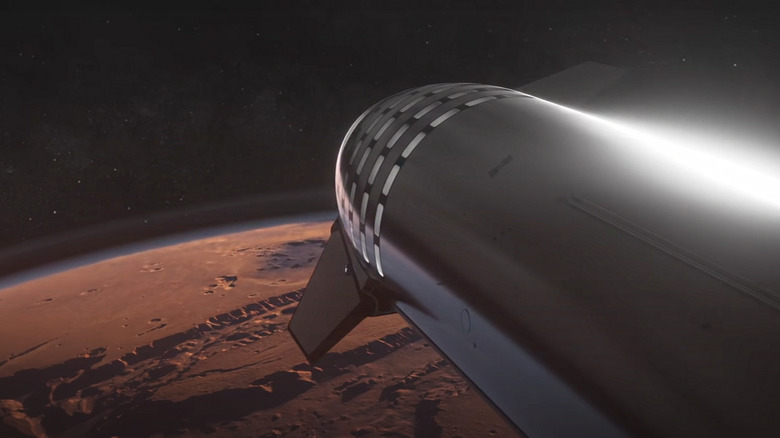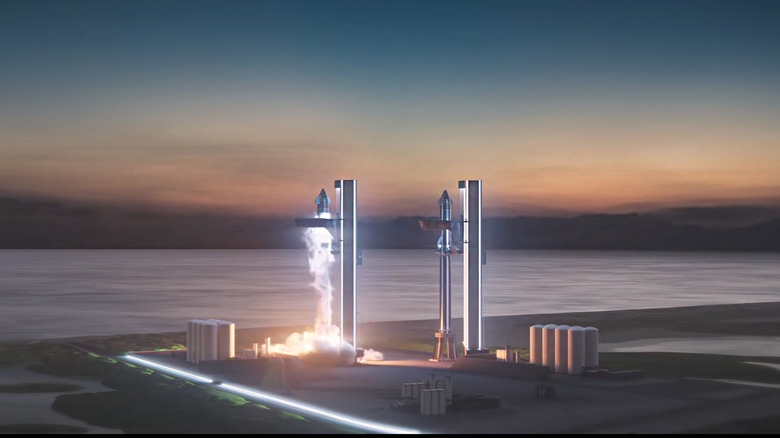What Elon Musk Has To Say About Sending A Starship To Mars
Elon Musk may usually be a man of few words where Twitter is concerned, but when he does speak, the internet is always there to listen. This time, Musk sent out two very succinct tweets about the recently revealed SpaceX Starship Animation video. The animation comes as part of a keynote, delivered by Musk himself on February 11, 2022, in which the SpaceX and Tesla CEO details the company's great plan to send humans to Mars — and not just in some distant, vague future, but soon.
The animation, later shared by Elon Musk on Twitter, is nothing short of breathtaking. Starship Animation features realistic visuals combined with a beautiful score that brings epics such as Interstellar to mind. Although the idea for humanity to colonize Mars is not quite as fantastical as what Christopher Nolan portrayed in Interstellar, we're still not quite there yet — but the SpaceX promotional video makes it seem like we're almost, almost, almost there.
Although it's best to watch the video for yourself and experience what I'm trying to describe, it does leave an impression on most viewers, at least if the flooded YouTube comment section is anything to go by. The 5-minute video shows us the journey from Earth to Mars, ending with a group of astronauts landing on a fully-colonized Mars. SpaceX's Starship Update serves as an extension of the video, talking in detail about what it's going to take for us to actually get there.
The Starship is as tall as a 40-story building
In the video, we can see Starship — the super-massive vehicle that Musk wants to use on his mission to send humans to Mars. The entire launch system is almost 400 feet tall, which is the equivalent of a 40-story building, and it is fully reusable. On its website, SpaceX mentions that the rocket is a "transportation system designed to carry both crew and cargo to Earth orbit, the Moon, Mars and beyond."
In addition to being the future of humanity, as SpaceX would probably call it, Starship is also a cargo ship made to carry massive amounts of cargo from Earth to orbit and then back. Interestingly enough, SpaceX also says that the rocket could be used to travel between destinations on Earth, and while that makes perfect sense, it seems outrageously expensive when airplanes actually exist.
With that said, there is no denying that SpaceX's Starship is hugely impressive. With a payload capacity of up to 150 tons, it's probably the closest thing to a realistic Mars spaceship that we have right now. Elon Musk himself has said in his tweet that this journey will take place during our lifetime. But how realistic is this idea of the Starship mission, and what kind of a timeline are we really looking at here?
When will Starship go to Mars?
So far, SpaceX's Mars program has been an ever-moving goal post, and that should come as no surprise. While there are rovers currently on Mars, humans have never come even close to going that far within the solar system. Despite that, SpaceX continues to have big plans for the future of humanity on Mars. Elon Musk himself has stated that he wants to build a self-sustaining city on Mars and colonize the planet with 1 million people by 2050. Before any of that can happen, there are many boxes left to check.
In his keynote, Musk talks about everything from orbital tests for the Starship to future Mars missions and problems that could potentially arise. SpaceX's Starship, being as massive as it is, requires special facilities in order to launch, especially if it will be launching regularly (SpaceX plans to use it to deliver new Starlink satellites to orbit). According to Musk, the only two options for a realistic Starship launch site are Boca Chica, Texas, or Cape Canaveral, Florida. The company is still waiting for various clearances to come through before committing to a certain launch spot.
Contrary to what the video suggests, we're not that close to colonizing Mars yet. SpaceX's Starship is yet to leave Earth's orbit. During the first Starship update in 2019 (as shown in the video above), Musk predicted that the spaceship may be able to fly people as early as 2020. SpaceX's CEO has now stated that we can expect to see the Starship in a test flight to orbit within 2022. Although Musk doesn't say so, further delays are likely as Mars colonization is still a dream. It may be another decade before the first manned mission lands on the Red Planet. However, even if we don't have a million people on Mars by the end of 2050, it seems very likely that humanity will travel there sooner rather than later, and that is a delightfully exciting thought.



